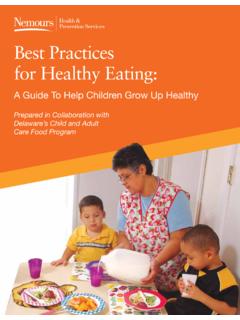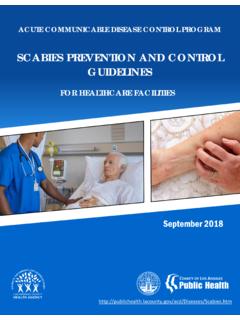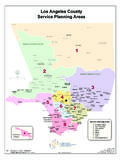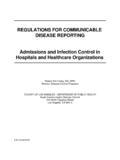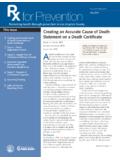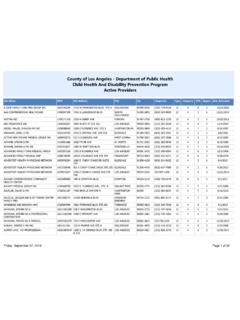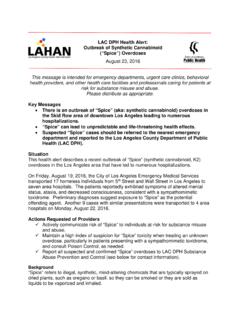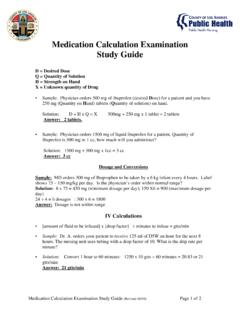Transcription of Public Health Nursing Practice Model
1 2007 LAC DPH - Public Health Nursing Public Health Nursing Practice Model Introduction A PHN Model was developed to describe the building blocks of PHN Practice and to delineate their relationship to each other. The Model communicates the foundation of the Practice to those within the discipline and also to Public Health colleagues from other disciplines. This narrative serves as an accompanying text to the diagram, elaborating on the components of the Model . Assumptions of Population-Based Practice and the Tenets of Public Health The Public Health Nursing Practice Model is built upon the assumption that Public Health Nursing Practice is population-based. Practice is population-based if it meets the following criteria, which are a blend of tenets developed by the Quad Council of Public Health Nursing Organizations1 and Minnesota Department of Health , PHN Section2: Focuses on entire populations possessing similar Health concerns or characteristics. Relies upon an assessment of population Health status.
2 Considers the broad determinants of Health . Considers all levels of prevention, with a preference for primary prevention. i. Primary Prevention: promoting Health , protecting against Health threats to the community, and keeping problems from occurring in the first place. ii. Secondary Prevention: detecting and treating problems in their early stages. It keeps problems from causing serious or long-term effects or from affecting others. iii. Tertiary Prevention: preventing existing problems from getting worse. Considers all levels of Practice . i. Individual/Family Focused Practice : changes knowledge, attitude, beliefs, values, practices , and behaviors of individuals, alone or as part of a family or group. ii. Community-Focused Practice : changes community norms, attitudes, awareness, practices , and behaviors of the population. iii. Systems-Focused Practice : changes organizations, policies, laws, and power structures of the systems that affect Health . Reaches out to all who might benefit, not focusing on just those who present themselves.
3 Demonstrates a dominant concern for the greater good of all the people. The interest of the whole take priority over the best interest of the individual or group. Creates healthy environmental, social, and economic conditions in which people can thrive. Supports resource allocation to achieve maximum population Health gain. Resources are allocated so that they will do the most good to the greatest number of people. Collaborates with members of other professions/organizations. These tenets permeate all aspects of the Public Health Nursing Practice Model to assure that Nursing Practice is grounded in a population-based perspective. 2007 LAC DPH - Public Health Nursing Interplay of the Key Components The PHN Practice Model is a melding of nationally recognized components: The Standards of PHN Practice1, the ten Essential Services3, Healthy People 20104 ten leading Health indicators, and Minnesota s Framework of seventeen PHN Interventions2. The Model is grounded in the precepts that PHN Practice uses a team approach, is population-based and has as its goal the creation of the conditions in which healthy people can live in healthy communities.
4 The diagram of this PHN Practice Model is a simplified representation of the concept and components of the Practice process. It is intended to present the key elements and the relationship among these elements. It is a tool for understanding and applying the Model to the reality of the Practice Health Nursing with the Public Health Team The Model begins with the depiction of Public Health Nursing as an integral part of an interdisciplinary team approach to Public Health Practice . Natural partners on the team with Public Health Nursing include nutritionists, physicians, social workers, Public Health investigators, environmental Health specialists, Health educators and representatives from the community, among others. The cause of most Public Health concerns can be traced to many factors and likewise the solutions require a multifaceted approach. Thus the team approach is crucial to success in any Public Health Nursing endeavor. Scope and Standards of PHN Practice In 1999, the leaders of the Quad Council of PHN Organizations recognized that PHN Practice was changing with a renewed emphasis on the improvement of the Health of the entire population.
5 This recognition prompted the Council to articulate a framework for PHN Practice that was population-based. Such a framework would help prepare Public Health Nursing to shift its Practice focus and to develop the capacity to articulate the aspects of the Practice that were unique to Public Health Nursing . This framework has been described by the Council in the Scope and Standards of Public Health Nursing Practice1. The Quad Council is comprised of: 1. American Nurses Association (ANA) Council for Community, Primary, and Long-Term Care Nursing Practice , 2. American Public Health Association PHN Section, 3. Association of Community Health Nursing Educators, and 4. Association of State and Territorial Directors of Nursing ..In 2004, a volunteer work group of Public Health and community Health Nursing stakeholders convened to review and revised the 1999 Scope and Standards to reflect contemporary Public Health Nursing Practice and to set a framework for future Practice . 2007 LAC DPH - Public Health Nursing The revised PHN Standards of Practice , as outlined in the Public Health Nursing : Scope and Standards of Practice , ( 2007 revision)6 includes the following components: 1.
6 Assessment 2. Population diagnosis and priorities 3. Outcome Identification 4. Planning 5. Implementation 6. Evaluation The six Standards of Practice describe a competent level of Public Health Nursing care as demonstrated by the critical thinking Model known as the Nursing process. Population-based Practice The Model depicts three interwoven circles that show the three levels of population-based Practice : individual and family, community and systems. The circles are nested within the overall label of population-based Practice , which applies at all points of the Nursing process described in the PHN Standards. Consideration must be given to all three levels of Practice at each step in the Nursing process. The Ten Essential Public Health Services The American Public Health Association3, in partnership with other Public Health associations, has described the fundamental Public Health services in language the general Public can understand. Using the three Public Health Core Functions of assessment, assurance, and policy development as a starting point, the ten Essential Public Health Services were defined (see page A8).
7 These essential services are easily incorporated into the Nursing process as described by the PHN Standards, demonstrating that the PHN Practice Model is consistent with nationally accepted Practice for all Public Health workers. This is an important consideration for a Model that has to be viable within an interdisciplinary Public Health team environment. Health Indicators PHN resources are often scarce and need to be directed thoughtfully in order to achieve Public Health improvement objectives. The consideration of Health indicators assists in this process at the assessment and diagnosis steps of the Nursing process. In deciding what indicators to choose, the Public Health team can be guided by work that has been done at the national level to identify the most important indicators for Health improvement of the population. Healthy People 20104 is the national agenda on Health promotion and prevention of disease, disability, and premature death. The Health objectives described in this agenda are designed to identify the most significant threats to Health and to establish national goals to reduce these threats.
8 Work continues to build on goals set forth in 1979 through national Health objectives established by the Surgeon General s report, Healthy People. These objectives, and those set forth in Healthy People 2000, can serve as a guide for the development of Health plans for states and for local communities. The two overarching goals of Healthy People 2010 are to increase quality and years of healthy life, and to eliminate Health disparities. The ten leading Health indicators represent the major Public Health concerns in the United States. They were chosen, Based on their ability to motivate action, the availability of data to measure progress, and their 2007 LAC DPH - Public Health Nursing relevance as broad Public Health issues. The indicators are: physical activity, overweight and obesity, tobacco use, substance abuse, responsible sexual behavior, mental Health , injury and violence, environmental quality, immunization, and access to Health care. Consideration of the ten leading Healthy People 2010 indicators during the initial steps of the Nursing process helps to ensure that Practice will be consistent with national priorities.
9 Local Indicators are an important additional consideration during assessment and diagnosis and can be addressed depending on local priorities and resources. Some communities may have pressing Public Health concerns not included in the Healthy People 2010 leading indicators and so must direct their energies accordingly. PHN Interventions The State of Minnesota Department of Health Services, Public Health Nursing Section2, spent several years identifying actions, or interventions , that Public Health Nursing utilizes on behalf of individuals, families and communities to improve and promote the Health status of populations. As a result of the study, seventeen PHN interventions were identified: surveillance, disease and Health event investigation, case finding, outreach, screening, referral and follow-up, case management, delegated function, Health teaching, counseling, consultation, collaboration, coalition building, community organizing, advocacy, social marketing, policy development and enforcement.
10 Minnesota recognized that there are three underlying assumptions to the seventeen interventions: 1. Selecting interventions is part of the planning step in the Nursing process. This means that assessment, diagnosis and problem identification have already occurred. 2. The interventions are grounded in an assessment of the community s Health . 3. Interventions may be implemented alone or in conjunction with other interventions. Summary The development of this Practice Model is a dynamic and cyclical process. It is responsive to the current application of the concepts to the reality of local Practice . Attempts to adjust the articulation of the Practice Model are continually made in reply to feedback, request for clarification, and recommendations for modifications for enhancing adaptation to the various Practice settings and populations served at the local level. References: 1 Quad Council of Public Health Nursing Organizations. (1999). Scope and Standards of Public Health Nursing Practice .
